Mercury 8
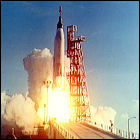 Astronaut Wally Schirra is the third American to orbit Earth, aboard the Mercury 8 capsule (nicknamed Sigma 7). He remains in orbit for just over nine hours in the cramped quarters of the Mercury spacecraft before splashing down.
Astronaut Wally Schirra is the third American to orbit Earth, aboard the Mercury 8 capsule (nicknamed Sigma 7). He remains in orbit for just over nine hours in the cramped quarters of the Mercury spacecraft before splashing down.
Vostok 4
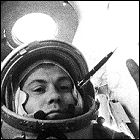 The Soviet Union launches Vostok 4 with Pavel Popovich aboard, while Andrian Nikolayev orbits overhead in Vostok 3. The two vehicles pass within four miles of one another, but with no precision maneuvering, rendezvous or docking equipment, there’s little practical engineering value in the tandem space flight, other than to prove that ground controllers can handle two simultaneous flights. Popovich returns to Earth after nearly three days.
The Soviet Union launches Vostok 4 with Pavel Popovich aboard, while Andrian Nikolayev orbits overhead in Vostok 3. The two vehicles pass within four miles of one another, but with no precision maneuvering, rendezvous or docking equipment, there’s little practical engineering value in the tandem space flight, other than to prove that ground controllers can handle two simultaneous flights. Popovich returns to Earth after nearly three days.
Vostok 3
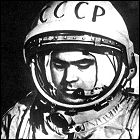 Andrian Nikolayev becomes the third Soviet cosmonaut to reach orbit. Aboard Vostok 3, Nikolayev remains in orbit for almost four days, long enough to become the first space traveler from Earth to have company while in orbit.
Andrian Nikolayev becomes the third Soviet cosmonaut to reach orbit. Aboard Vostok 3, Nikolayev remains in orbit for almost four days, long enough to become the first space traveler from Earth to have company while in orbit.
Mercury 7
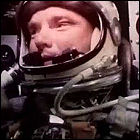 The second American orbital flight is launched, with Scott Carpenter lifting off aboard Mercury 7 (nicknamed Aurora 7). Carpenter’s five-hour, three-orbit mission is almost a carbon copy of John Glenn’s orbital flight, the primary goal being to duplicate the flight and compare the two astronauts’ reports and reactions.
The second American orbital flight is launched, with Scott Carpenter lifting off aboard Mercury 7 (nicknamed Aurora 7). Carpenter’s five-hour, three-orbit mission is almost a carbon copy of John Glenn’s orbital flight, the primary goal being to duplicate the flight and compare the two astronauts’ reports and reactions.
Mercury 6: first American in orbit
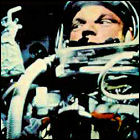 The third manned Mercury flight, Friendship 7, puts John Glenn in orbit for nearly five hours, the first American astronaut to circle the Earth. The retro-rocket package on Glenn’s vehicle, Friendship 7, becomes an issue when a sensor indicates that the heat shield protecting the capsule’s interior from the intense heat of reentry has slipped. Intended to be cast off before reentry, the retro package is left on at the insistence of ground controllers, resulting in an unusually rough ride home after only three orbits.
The third manned Mercury flight, Friendship 7, puts John Glenn in orbit for nearly five hours, the first American astronaut to circle the Earth. The retro-rocket package on Glenn’s vehicle, Friendship 7, becomes an issue when a sensor indicates that the heat shield protecting the capsule’s interior from the intense heat of reentry has slipped. Intended to be cast off before reentry, the retro package is left on at the insistence of ground controllers, resulting in an unusually rough ride home after only three orbits.
Apollo unveiled
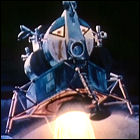 Weeks before an American astronaut first makes it to orbit, NASA unveils the design of the two Apollo spacecraft: a command/service module (large compared to the Mercury capsules Americans have already seen) and a completely un-aerodynamic lunar module whose unique shape, designed solely for landing on the moon, will never need to operate inside an atmosphere. Though further refinements in both designs are still to come, NASA has already decided on the basic shape of its crash lunar exploration program whose goal is to land a man on the moon before 1970.
Weeks before an American astronaut first makes it to orbit, NASA unveils the design of the two Apollo spacecraft: a command/service module (large compared to the Mercury capsules Americans have already seen) and a completely un-aerodynamic lunar module whose unique shape, designed solely for landing on the moon, will never need to operate inside an atmosphere. Though further refinements in both designs are still to come, NASA has already decided on the basic shape of its crash lunar exploration program whose goal is to land a man on the moon before 1970.
Mercury 5: first American monkey in orbit
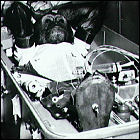 Prior to putting an astronaut in orbit, NASA launches a chimpanzee named Enos on a two-orbit Mercury flight to validate the survivability of the spacecraft for an extended flight. Enos is recalled to Earth when both his spacesuit and his Mercury capsule begins heating up unexpectedly, and attitude control is lost; after three hours and two orbits, Mercury 5 returns to Earth. While hauling the capsule from the ocean, recovery crews accidentally crack the window. Despite all this, Enos is safely returned home; he dies a year later from an illness not related to his orbital flight.
Prior to putting an astronaut in orbit, NASA launches a chimpanzee named Enos on a two-orbit Mercury flight to validate the survivability of the spacecraft for an extended flight. Enos is recalled to Earth when both his spacesuit and his Mercury capsule begins heating up unexpectedly, and attitude control is lost; after three hours and two orbits, Mercury 5 returns to Earth. While hauling the capsule from the ocean, recovery crews accidentally crack the window. Despite all this, Enos is safely returned home; he dies a year later from an illness not related to his orbital flight.
Saturn I
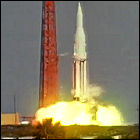 An unmanned Saturn I rocket is launched, the first practical demonstration of the multiple-engine design which has already been earmarked for future Apollo missions to the moon. Designed by expatriate German rocket engineer Werhner von Braun, the Saturn I is the first iteration of a family of heavy-lift rockets that will include the Saturn IB and the Saturn V; in this configuration, the Saturn I is the first stage of a Saturn V with no second stage.
An unmanned Saturn I rocket is launched, the first practical demonstration of the multiple-engine design which has already been earmarked for future Apollo missions to the moon. Designed by expatriate German rocket engineer Werhner von Braun, the Saturn I is the first iteration of a family of heavy-lift rockets that will include the Saturn IB and the Saturn V; in this configuration, the Saturn I is the first stage of a Saturn V with no second stage.
MIT to design Apollo spacecraft computers
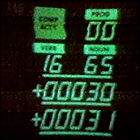 The first government contract is issued in the Apollo lunar landing program, as MIT lands the contract to develop the guidance and navigation computer at the heart of the Apollo vehicles. For its day, MIT designed one of the most robust computers that early ’60s technology could squeeze into such a small space; modern digital watches are far more powerful than that computer. The same computer system will be installed in both the command module and the lunar module.
The first government contract is issued in the Apollo lunar landing program, as MIT lands the contract to develop the guidance and navigation computer at the heart of the Apollo vehicles. For its day, MIT designed one of the most robust computers that early ’60s technology could squeeze into such a small space; modern digital watches are far more powerful than that computer. The same computer system will be installed in both the command module and the lunar module.
Vostok 2
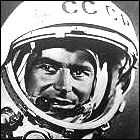 The Soviet Union launches its second manned spacecraft, Vostok 2, with cosmonaut Gherman Titov aboard. This mission sets a new space endurance record, with Titov spending just over one day in orbit, circling Earth 17 times in the process. Later accounts show that it’s not a pleasant day in orbit: Titov is reportedly the first sufferer of space sickness, vomiting in the cabin of his Vostok capsule.
The Soviet Union launches its second manned spacecraft, Vostok 2, with cosmonaut Gherman Titov aboard. This mission sets a new space endurance record, with Titov spending just over one day in orbit, circling Earth 17 times in the process. Later accounts show that it’s not a pleasant day in orbit: Titov is reportedly the first sufferer of space sickness, vomiting in the cabin of his Vostok capsule.
Mercury 4: a sinking feeling
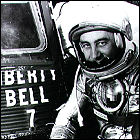 The second American in space is Virgil “Gus” Grissom, pilot of the Mercury 4 capsule Liberty Bell 7. Like Alan Shepard’s flight, Grissom’s launch reaches an altitute of 118 miles and splashes down 15 minutes later, but mechanical problems with the explosive bolts to release the capsule’s hatch allow water into the vehicle. Grissom has to bail out at sea, wearing a spacesuit that’s rapidly taking on water, while Liberty Bell 7 sinks to the bottom of the Atlantic. Grissom weathers repeated accusations that he manually blew the hatch and caused his vehicle to sink, a claim which is later disproven.
The second American in space is Virgil “Gus” Grissom, pilot of the Mercury 4 capsule Liberty Bell 7. Like Alan Shepard’s flight, Grissom’s launch reaches an altitute of 118 miles and splashes down 15 minutes later, but mechanical problems with the explosive bolts to release the capsule’s hatch allow water into the vehicle. Grissom has to bail out at sea, wearing a spacesuit that’s rapidly taking on water, while Liberty Bell 7 sinks to the bottom of the Atlantic. Grissom weathers repeated accusations that he manually blew the hatch and caused his vehicle to sink, a claim which is later disproven.
Mercury 3: first American in space
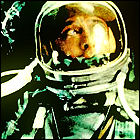 Alan B. Shepard, aboard the Freedom 7 Mercury capsule, becomes the first American in space when he is launched on a fifteen-minute suborbital flight from Cape Canaveral, splashing down in the Atlantic Ocean. The Mercury spacecraft offers its pilot more maneuverability than the Soviet Vostok vehicle, which is almost entirely controlled from the ground.
Alan B. Shepard, aboard the Freedom 7 Mercury capsule, becomes the first American in space when he is launched on a fifteen-minute suborbital flight from Cape Canaveral, splashing down in the Atlantic Ocean. The Mercury spacecraft offers its pilot more maneuverability than the Soviet Vostok vehicle, which is almost entirely controlled from the ground.
Vostok 1: the first human in space
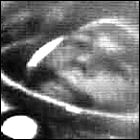 The Soviet Union scores another technological victory, launching cosmonaut Yuri Gagarin aboard Vostok 1 into a single orbit of Earth lasting a little over 100 minutes. After that orbit, Gagarin’s Vostok return capsule carries him safely through the atmosphere; he then triggers an ejection seat which punches him out of the capsule, at which point he parachutes to the ground.
The Soviet Union scores another technological victory, launching cosmonaut Yuri Gagarin aboard Vostok 1 into a single orbit of Earth lasting a little over 100 minutes. After that orbit, Gagarin’s Vostok return capsule carries him safely through the atmosphere; he then triggers an ejection seat which punches him out of the capsule, at which point he parachutes to the ground.
Mercury 2: canned Ham
 The first living creature to reach space aboard an American rocket is Ham, a chimpanzee wired with electrodes and sensors to determine the effects of space travel on a higher primate whose body might react similarly to that of a human being. NASA sends Ham on the sixteen-minute suborbital Mercury 2 flight, ending in a splashdown in the Atlantic. Both Ham and his vehicle survive the flight despite numerous equipment glitches in both the Redstone rocket and the Mercury capsule itself (which actually blasts away from the Redstone via its launch abort system), which loses cabin pressure (fortunately, Ham has his own spacesuit to protect him) and then puts its primate pilot through a punishing 17G reentry. For his pioneering feat of spaceflight, Ham receives an apple, an orange, and paid retirement to the National Zoo.
The first living creature to reach space aboard an American rocket is Ham, a chimpanzee wired with electrodes and sensors to determine the effects of space travel on a higher primate whose body might react similarly to that of a human being. NASA sends Ham on the sixteen-minute suborbital Mercury 2 flight, ending in a splashdown in the Atlantic. Both Ham and his vehicle survive the flight despite numerous equipment glitches in both the Redstone rocket and the Mercury capsule itself (which actually blasts away from the Redstone via its launch abort system), which loses cabin pressure (fortunately, Ham has his own spacesuit to protect him) and then puts its primate pilot through a punishing 17G reentry. For his pioneering feat of spaceflight, Ham receives an apple, an orange, and paid retirement to the National Zoo.
Project Mercury
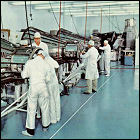 The newly-formed NASA reveals a bold plan: Project Mercury will be an extensive program to create a vehicle capable of safely sending men into Earth orbit and returning them in one piece. The rigorous selection process to find the country’s first space pilots – astronauts – begins, focusing on combat pilots and especially test pilots with experience in flying unproven experimental aircraft (the Mercury spacecraft will definitely qualify for this description).
The newly-formed NASA reveals a bold plan: Project Mercury will be an extensive program to create a vehicle capable of safely sending men into Earth orbit and returning them in one piece. The rigorous selection process to find the country’s first space pilots – astronauts – begins, focusing on combat pilots and especially test pilots with experience in flying unproven experimental aircraft (the Mercury spacecraft will definitely qualify for this description).
Nuclear Pulse Propulsion
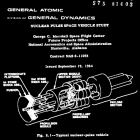 As part of a post-Manhattan-Project program of seeking peaceful uses for the technology previously developed for the construction and delivery of nuclear weapons, an informal report authored in August by C.J. Everett and Stanislaw Ulam is distributed from Los Alamos National Laboratory to the Atomic Energy Commission and other interested parties on this date. The report outlines a theoretical space propulsion system which would eject and detonate a series of nuclear explosives behind a spacecraft, pushing it forward at high velocity. The suggested spacecraft design would carry a pusher plate and shock-absorber system to minimize the acceleration effects on crew members in a shielded payload section. This is the culmination of a series of ideas Ulam had devised over the past decade, which would theoretically put interplanetary or even interstellar travel within reach. As the space race heats up, Ulam and Everett’s proposal will be revisited and expanded upon, at least on paper; physicist Freeman Dyson, in particular, will spend considerable time and research on what will come to be known as Project Orion (unrelated to the 21st century Orion crewed spacecraft design).
As part of a post-Manhattan-Project program of seeking peaceful uses for the technology previously developed for the construction and delivery of nuclear weapons, an informal report authored in August by C.J. Everett and Stanislaw Ulam is distributed from Los Alamos National Laboratory to the Atomic Energy Commission and other interested parties on this date. The report outlines a theoretical space propulsion system which would eject and detonate a series of nuclear explosives behind a spacecraft, pushing it forward at high velocity. The suggested spacecraft design would carry a pusher plate and shock-absorber system to minimize the acceleration effects on crew members in a shielded payload section. This is the culmination of a series of ideas Ulam had devised over the past decade, which would theoretically put interplanetary or even interstellar travel within reach. As the space race heats up, Ulam and Everett’s proposal will be revisited and expanded upon, at least on paper; physicist Freeman Dyson, in particular, will spend considerable time and research on what will come to be known as Project Orion (unrelated to the 21st century Orion crewed spacecraft design).
Man will conquer space soon
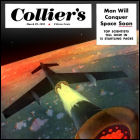 Collier’s Magazine publishes an extensive pictorial article with text by space pioneers Wernher von Braun and Willy Ley, and illustrations by Chesley Bonestell, positing a future with plane-like spacecraft making routine trips to orbiting space stations. The article suggests that the station could be a reality in ten years and “twice the cost of the atom bomb” if the public shows its support for space exploration. Though spaceplanes and stations are more than a decade away, the Collier’s article is a seminal moment in the space age.
Collier’s Magazine publishes an extensive pictorial article with text by space pioneers Wernher von Braun and Willy Ley, and illustrations by Chesley Bonestell, positing a future with plane-like spacecraft making routine trips to orbiting space stations. The article suggests that the station could be a reality in ten years and “twice the cost of the atom bomb” if the public shows its support for space exploration. Though spaceplanes and stations are more than a decade away, the Collier’s article is a seminal moment in the space age.
Operation Paperclip
 President Truman, after months of weighing the pros and cons of offering amnesty to many of the German scientists involved in the V2 rocket program, signs off on Operation Paperclip, a project to repatriate those scientists to the United States. The initial estimate is that a thousand German scientists will be brought to the U.S., but over time the total will grow closer to 2,000, bringing well over 3,000 family members with them. Wernher von Braun and Hermann Oberth are among the scientists and engineers who accept the offer to work for the U.S., and their efforts, while they do have military value, will form the core of the nascent U.S. space program, with von Braun eventually designing the Saturn V rocket that will take future astronauts to the moon. The Soviet Union mounts a similar program in the weeks to come, attempting to repatriate German scientists and engineers to continue their rocketry research for the Soviets.
President Truman, after months of weighing the pros and cons of offering amnesty to many of the German scientists involved in the V2 rocket program, signs off on Operation Paperclip, a project to repatriate those scientists to the United States. The initial estimate is that a thousand German scientists will be brought to the U.S., but over time the total will grow closer to 2,000, bringing well over 3,000 family members with them. Wernher von Braun and Hermann Oberth are among the scientists and engineers who accept the offer to work for the U.S., and their efforts, while they do have military value, will form the core of the nascent U.S. space program, with von Braun eventually designing the Saturn V rocket that will take future astronauts to the moon. The Soviet Union mounts a similar program in the weeks to come, attempting to repatriate German scientists and engineers to continue their rocketry research for the Soviets.
Operation Overcast
 After Germany’s surrender, ending the European hostilities in World War II, American military forces embark on a program to recruit captured German scientists, particularly those involved in the development of rockets and missiles, to perform further research and development in these areas for the United States, especially with the Pacific war between the United States and Japan still very much an active concern. The German scientists are also interrogated to find out if any of their technology has been shared with Japan. Numerous German rocket scientists, notably Wernher von Braun and Eberhard Rees, are identified as possible assets to the American war effort despite their past affiliations with Germany’s Nazi regime.
After Germany’s surrender, ending the European hostilities in World War II, American military forces embark on a program to recruit captured German scientists, particularly those involved in the development of rockets and missiles, to perform further research and development in these areas for the United States, especially with the Pacific war between the United States and Japan still very much an active concern. The German scientists are also interrogated to find out if any of their technology has been shared with Japan. Numerous German rocket scientists, notably Wernher von Braun and Eberhard Rees, are identified as possible assets to the American war effort despite their past affiliations with Germany’s Nazi regime.